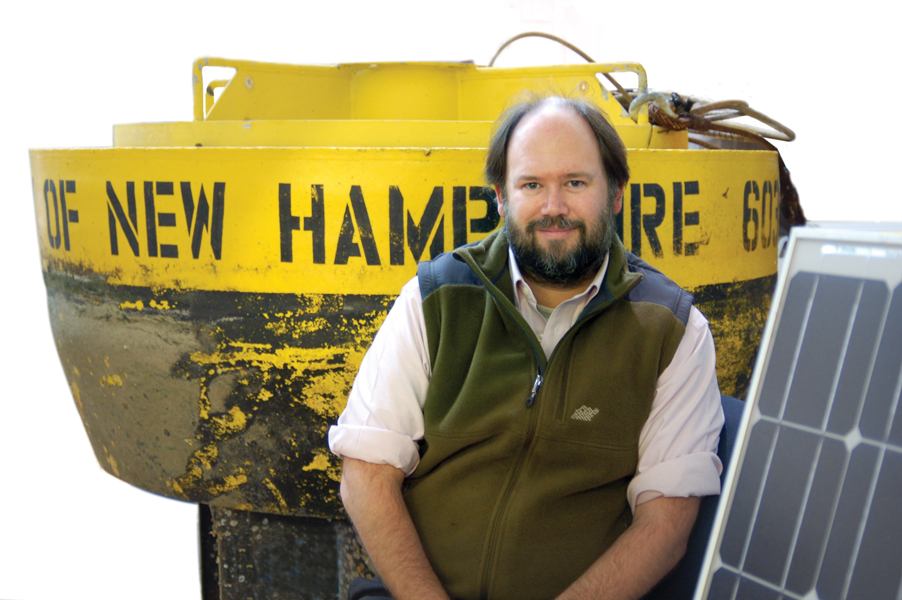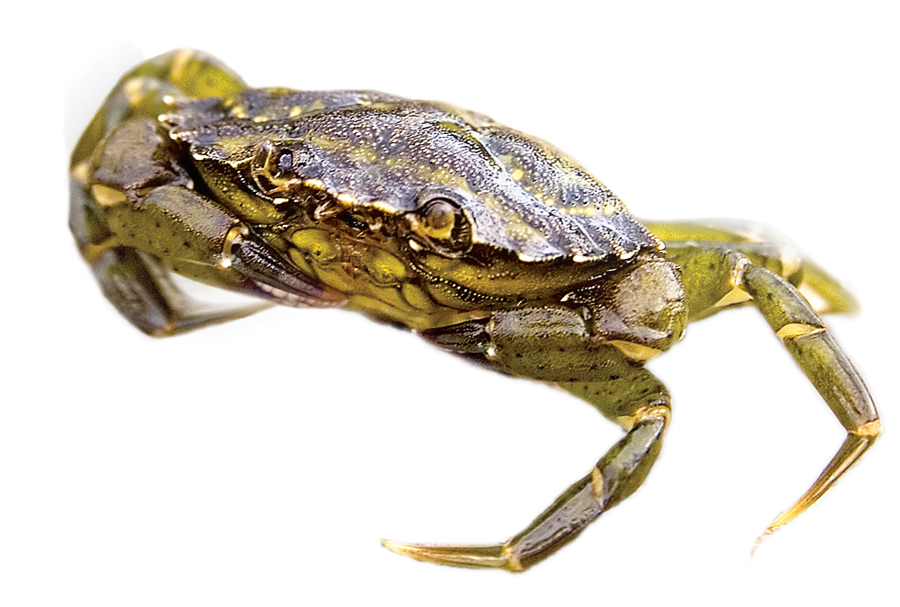Muddy Waters
MOST OF JAMIE PRINGLE'S RESEARCH papers are co-authored with colleagues working in other disciplines. It’s just part of his modus operandi as he straddles investigations in his own areas of expertise in both physical and biological oceanography.
While such an approach can cloud the waters of research with extra complexity in the short term, “Anything you do at the interface of disciplines, if successful, is likely to be more interesting,” Pringle asserts.
Take, for example, a scientific investigation into why an invasive crab is suddenly and surprisingly expanding its habitat in the Gulf of Maine along the coast of Nova Scotia – something Pringle and colleagues are currently working on with respect to the species Carcinus maenas or the European green crab. The crab is listed among the top 100 of the planet’s worst invasive alien species.
The multidisciplinary team is tackling the problem from the perspective of physical ocean processes, population genetics, and reproductive strategies, among other aspects. All of which means things can get a little confusing.
“If you’re not working directly with folks in other disciplines the tendency is to try and get rid of at least part of the confusion by assuming that the other side is more or less worked out,” says Pringle, an associate professor in the Ocean Process and Analysis Laboratory and Department of Earth Sciences. He adds, “And the easiest way to do that is simply not talk to them.”
But by working with colleagues in other fields Pringle et al. can build a stronger case with fewer assumptions, fewer gray areas.
Pringle has built his career by, in a sense, muddying his research waters. He took a Ph.D. in physical oceanography from MIT and the Woods Hole Oceanographic Institution and did post-doctoral work at the Scripps Institution of Oceanography in biological oceanography.
“There’s always the question of whether you should be more concentrated or more diluted in your research. I’m more diluted,” Pringle says.
What this means, for example, is that as a physical oceanographer Pringle has better mathemat ical modeling skills than many of his biological counterparts.
“I’m bringing simple, quantitatively realistic models of the physics to the biological side of things,” he says. Moreover, as a physical oceanographer, Pringle can stress to his colleagues that they have to pay attention to the complexities of the circulation of the ocean – the mean flow, the eddies – all aspects of reality for larvae drifting in the ocean.
“It’s applying what we understand of the physics of the ocean to a biological problem, and that’s a new thing,” he says.
For example, in the case of Carcinus maenas, Pringle is looking at the physical processes, like ocean currents, that cause crab larvae to drift and, eventually, expand their territory.
In contrast, when just looking at the biological side of the equation the focus is typically on mortality and temperature: species will spread north until it gets too cold – end of story. True enough, but what Pringle and his co-authors stress in their work is that the flow of the ocean modifies that result greatly, that the physics can’t be ignored or excessively oversimplified for convenience sake.
“The art of science is to make things as simple as you can and no simpler,” Pringle says. “A lot of the discussion of what sets range boundaries in organisms with drifting larvae in the ocean, or what maintains genetic differences between populations that are geographically close to each other, has become too simple. The explanations are not right because they’ve left out things that are not less important but, rather, more important.”
In late December of last year, Pringle was invited to give a talk at the American Geophysical Union annual meeting in San Francisco on the research he and colleagues are conducting to better understand how newly introduced variants of Carcinus maenas are spreading, displacing the existing crabs, and changing the genetic makeup of the population.
Although this was thought to be a simple case of range expansion, genetic analysis done by Pringle’s colleague Joe Roman of the University of Vermont has shown that the northern population is genetically distinct from its southern counterpart, and thus appears to be a new introduction from northern Europe.
Says Pringle, “So these are two distinct populations of Carcinus maenas in the north and south and, with funding from the Census for Marine Life, we’ve been researching the downstream invasion of the new, northern population via the mean currents.” The work shows that the spread has not occurred as far as scientists would have expected.
Carcinus maenas can fundamentally alter the ecosystems it invades – it eats many commercially important shellfish and will damage the livelihoods of those who depend on these species.
However, Pringle points out, the importance of the work he and colleagues are doing goes farther than just this particular invasive species on this particular coast. As climate change gathers steam, and the temperature and currents in the coastal ocean change, many species will be unable to live in their altered habitat.
For many species, their ability to survive and adapt to a rapidly changing climate will be controlled by how quickly they can invade new coastal regions whose climates are capable of supporting them. If a species can shift its range poleward towards cooler waters faster than the climate is changing, and if there is suitable habitat, it will likely persist. If not, it could go extinct.
“How quickly species can expand their ranges into more favorable areas will ultimately control how they can adapt to a changing climate. Understanding these processes will give us insights into which species will adapt, and which will not.”
While such an approach can cloud the waters of research with extra complexity in the short term, “Anything you do at the interface of disciplines, if successful, is likely to be more interesting,” Pringle asserts.
Take, for example, a scientific investigation into why an invasive crab is suddenly and surprisingly expanding its habitat in the Gulf of Maine along the coast of Nova Scotia – something Pringle and colleagues are currently working on with respect to the species Carcinus maenas or the European green crab. The crab is listed among the top 100 of the planet’s worst invasive alien species.
The multidisciplinary team is tackling the problem from the perspective of physical ocean processes, population genetics, and reproductive strategies, among other aspects. All of which means things can get a little confusing.
Jamie Pringle. Photo: K.Donahue, UNH-EOS |
“If you’re not working directly with folks in other disciplines the tendency is to try and get rid of at least part of the confusion by assuming that the other side is more or less worked out,” says Pringle, an associate professor in the Ocean Process and Analysis Laboratory and Department of Earth Sciences. He adds, “And the easiest way to do that is simply not talk to them.”
But by working with colleagues in other fields Pringle et al. can build a stronger case with fewer assumptions, fewer gray areas.
Pringle has built his career by, in a sense, muddying his research waters. He took a Ph.D. in physical oceanography from MIT and the Woods Hole Oceanographic Institution and did post-doctoral work at the Scripps Institution of Oceanography in biological oceanography.
“There’s always the question of whether you should be more concentrated or more diluted in your research. I’m more diluted,” Pringle says.
What this means, for example, is that as a physical oceanographer Pringle has better mathemat ical modeling skills than many of his biological counterparts.
“I’m bringing simple, quantitatively realistic models of the physics to the biological side of things,” he says. Moreover, as a physical oceanographer, Pringle can stress to his colleagues that they have to pay attention to the complexities of the circulation of the ocean – the mean flow, the eddies – all aspects of reality for larvae drifting in the ocean.
“It’s applying what we understand of the physics of the ocean to a biological problem, and that’s a new thing,” he says.
Carcinus maenas, the European green crab |
In contrast, when just looking at the biological side of the equation the focus is typically on mortality and temperature: species will spread north until it gets too cold – end of story. True enough, but what Pringle and his co-authors stress in their work is that the flow of the ocean modifies that result greatly, that the physics can’t be ignored or excessively oversimplified for convenience sake.
“The art of science is to make things as simple as you can and no simpler,” Pringle says. “A lot of the discussion of what sets range boundaries in organisms with drifting larvae in the ocean, or what maintains genetic differences between populations that are geographically close to each other, has become too simple. The explanations are not right because they’ve left out things that are not less important but, rather, more important.”
In late December of last year, Pringle was invited to give a talk at the American Geophysical Union annual meeting in San Francisco on the research he and colleagues are conducting to better understand how newly introduced variants of Carcinus maenas are spreading, displacing the existing crabs, and changing the genetic makeup of the population.
Although this was thought to be a simple case of range expansion, genetic analysis done by Pringle’s colleague Joe Roman of the University of Vermont has shown that the northern population is genetically distinct from its southern counterpart, and thus appears to be a new introduction from northern Europe.
Says Pringle, “So these are two distinct populations of Carcinus maenas in the north and south and, with funding from the Census for Marine Life, we’ve been researching the downstream invasion of the new, northern population via the mean currents.” The work shows that the spread has not occurred as far as scientists would have expected.
Carcinus maenas can fundamentally alter the ecosystems it invades – it eats many commercially important shellfish and will damage the livelihoods of those who depend on these species.
However, Pringle points out, the importance of the work he and colleagues are doing goes farther than just this particular invasive species on this particular coast. As climate change gathers steam, and the temperature and currents in the coastal ocean change, many species will be unable to live in their altered habitat.
For many species, their ability to survive and adapt to a rapidly changing climate will be controlled by how quickly they can invade new coastal regions whose climates are capable of supporting them. If a species can shift its range poleward towards cooler waters faster than the climate is changing, and if there is suitable habitat, it will likely persist. If not, it could go extinct.
“How quickly species can expand their ranges into more favorable areas will ultimately control how they can adapt to a changing climate. Understanding these processes will give us insights into which species will adapt, and which will not.”
by David Sims, Science Writer, Institute for the Study of Earth, Oceans, and Space. Published in Winter 2009 issue of EOS .


